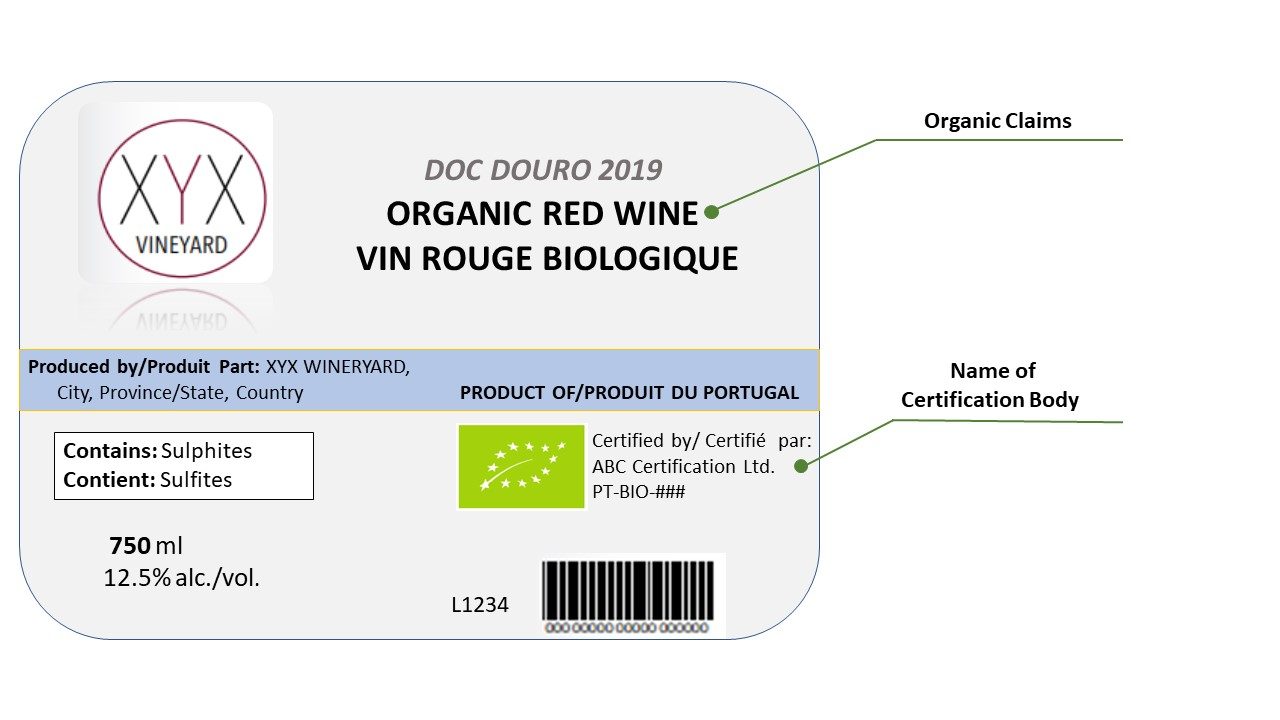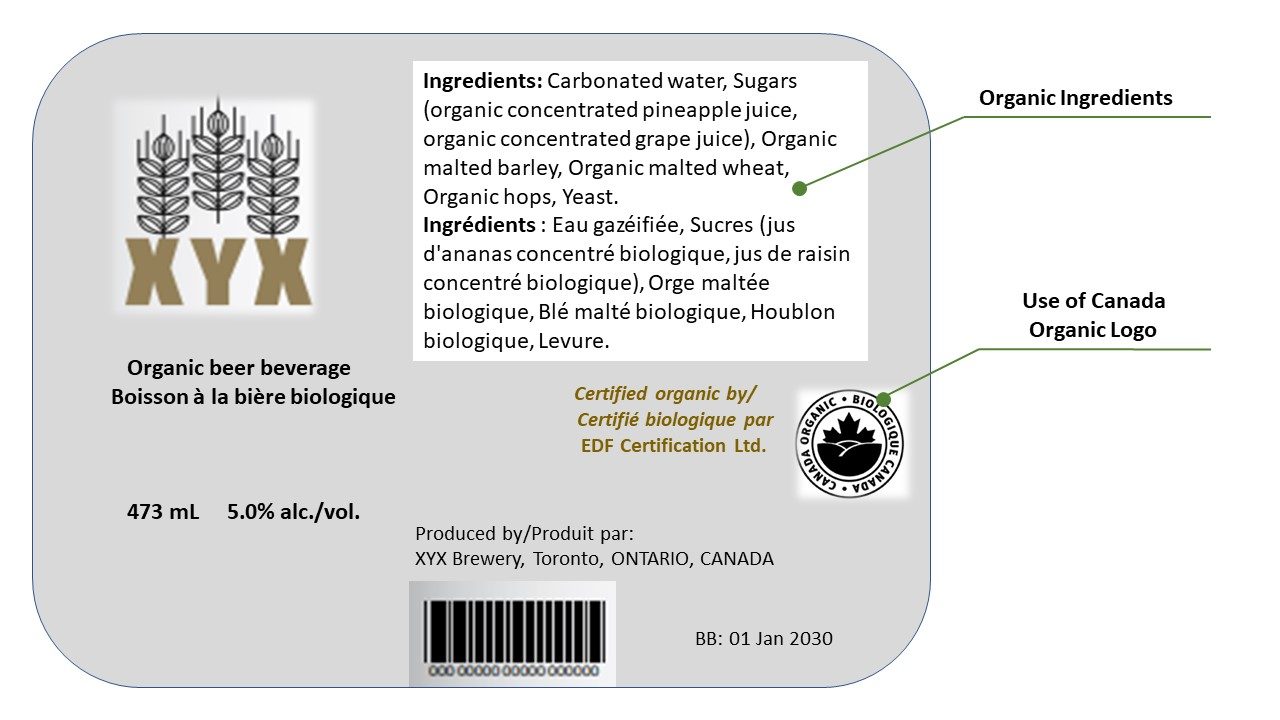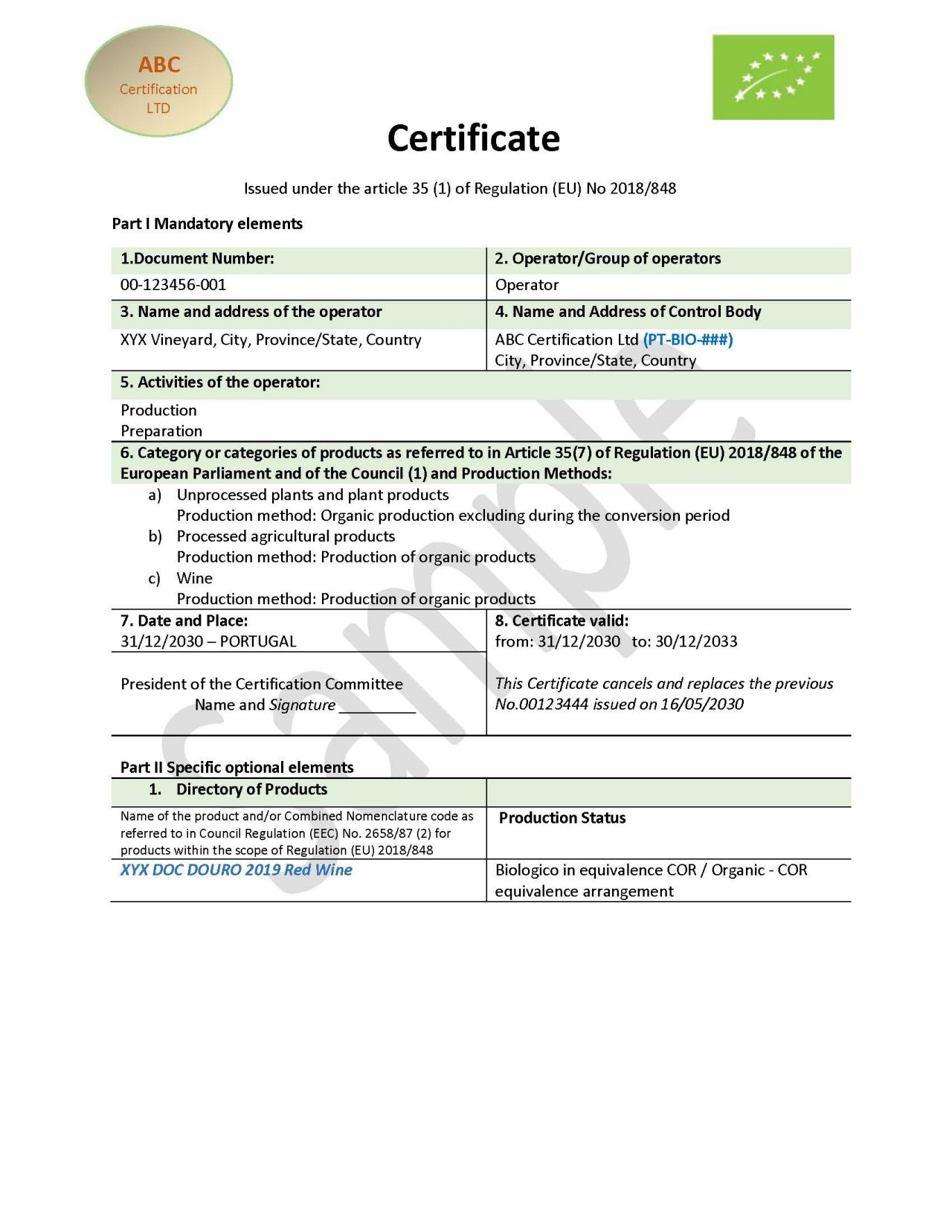An organic product is an agriculture product that has been certified as organic under part 13 of the Safe Food for Canadians Regulations (SFCR). Foods making organic claims must also meet Canadian Labelling requirements.
Imported Wine Label Example

Mandatory Label Requirements
Organic claims: Only products with organic content that is greater than or equal to 95% may be labelled or advertised as “organic” or bear the organic logo. Terms such as “organically grown”, “organically raised”, “organically produced”, or similar words are considered the same as “organic” claims.
Bilingual requirements: The “organic” claim must appear on the label in both French and English.
Name of certification body: The label of an organic product subject to part 13 of the SFCR must bear the name of the certification body that has certified the product as organic. The certification body can be identified anywhere on the product except the bottom of the container.
Organic ingredients: When ingredient list is required or voluntarily provided, the organic contents must be identified as organic in the list of ingredients.
Use of the Canada organic logo: Only permitted on products that have an organic content that is greater than or equal to 95% and have been certified according to the requirements of the Canada Organic Regime (COR). The use of the organic logo is voluntary but when used it must comply with Part 13 of the SFCR.
Imported products that bear the Canada organic logo must include:
• the statement “product of”, immediately preceding the name of the country of origin, or
• the statement “imported”, in close proximity to the logo.
These statements must appear on the label in both French and English.
Domestic Unstandardized Product Label Example

Imported Organic Products
Imported or interprovincially trade products making an organic claim must be certified under the Canada Organic Regime (COR). Organic products imported from countries with whom Canada has established an Equivalency Arrangement must be certified as per the terms of the arrangement. As a result, both the exporting country’s organic logo and the Canada organic logo may be used on products traded under the arrangement. For example, EU operators can use Canada organic logo in accordance with the Part 13 of the SFCR, as well as the EU organic logo as set out in the Commission Regulation (EC) No 889/2008.
As per the Canada Organic Regime import requirement from CFIA, anyone who imports organic products must be able to present a valid organic certificate when requested at any time, including at the time of import. To fulfill this requirement, LCBO requires a valid organic certificate that meets the Canadian Organic Standard for every organic product.
The organic certificate must be issued by a Certification Body that is accredited by CFIA, or officially recognized under an existing organic equivalency arrangement between Canada and a foreign country. At present, Canada has trade agreements in place with Costa Rica, the European Union, Japan, Mexico, South Korea, Switzerland, Taiwan, United Kingdom, and the United States. For countries without equivalency arrangements with Canada, the product may still be considered organic in Canada if it is certified in accordance with the terms of an equivalency arrangement.
Certification Body’s Accreditation Number (see definition on page 2)
CANADA – The code format is “COR XXXXXXXX”. The list of accredited Certification Bodies can be found in List of certification bodies under the Canada Organic Regime
EUROPEAN UNION – The code format is “AB-CDE-999”, which is required to be displayed next to the EU organic logo on product label. It is available in the list of Control Authorities in Charge of Controls in the Organic Sector.
AB - the country where the controls take place
CDE - three letter term that establishes a link with the organic production method, such as “org”, “eko”, “bio”, etc.
999 - reference number, indicated to a maximum of three digits
UNITED KINGDOM – The code format is “GB-ORG-XX”, which is required to display on product label. It is available in the list of approved UK organic control bodies.
UNITED STATES – The format is a 3-digit NOP code, which can be found in USDA Organic Integrity Database.
Links for the remaining countries can be found in the flowchart mentioned below.
How to Check Organic Certificates for Validity
Agencies and importers have the responsibility to guard against fraudulent practices and exercise caution when purchasing from suppliers. A flowchart provided by CFIA can be used to determine if an organic product certificate is valid for marketing an organic product in Canada. Please note under United States-Canada Organic Equivalence Arrangement – USCOEA, the organic certificate must include the following statement: "Certified in accordance with the terms of the US-Canada Organic Equivalency Arrangement”.
The format of organic product certificates varies depending on the country of certification. A valid organic product certificate must accompany each shipment and should include the following elements:

Operator is any food producer that markets finished and labelled organic products which comply with the Canadian Organic Standards under COR. The Operator Name listed should coincide with the name of business shown on the label. If the Operator name differs from LCBO Vendor Name, please advise LCBO and attain a note to confirm a business relationship.
Certification Body and Accreditation number can be found in the CFIA list of control bodies and control authorities. For products certified in the EU and UK, the product label must include an accreditation number (also known as control body code).
The code in this sample is “PT-BIO-###”.
Organic Standard or Regulation used to verify production for certification as recognized under COR. If the country of certification is not Canada, the organic standard used should be recognized under an Equivalency Arrangement.
Certificate Issue Date and Annual Inspection Date indicate the certification is current. Or a Certificate validity period may be present.
Finished product name as listed on organic certificate (including vintage year if applicable) / The finished product name may be found in the Annex, Approved Product List, or Directory of Products section. The product name listed should coincide with the label.
Production Status should show organic/biologique
________
Published August 2022, updated to align with the CFIA’s Food Modernization Initiative and the Safe Food for Canadians Act & Regulations. In producing these simplified guidelines, some requirements may not have been included and some may be ambiguous. The LCBO takes no responsibility for any problems / errors in label design resulting from using these guidelines. It is the supplier responsibility to ensure that a product label complies with all applicable Canadian laws, Canadian Association of Liquor Jurisdictions (CALJ) standards, and LCBO Product Packaging Standards and other LCBO operational and policy requirements.
